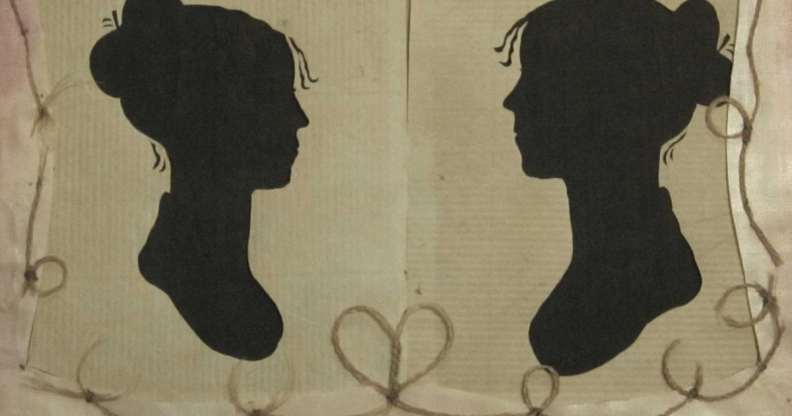The inspiring, true lesbian love story behind this simple 1800s portrait is better than any movie

(Public Domain)
We all know that LGBT+ people have been around since the dawn of, well, people – however the erasure of our history means that our stories have often faded into the mists of time.
LGBT+ people have historically had to live in the shadows and hide their truth, to avoid prosecution and persecution. However, occasionally some accounts of gay and lesbian love do make it down to us through the ages, reminding us that we’ve always been around.
One of these stories is the inspiring tale of Charity Bryant and Sylvia Drake, whose portraits were the subject of an exhibition in the Smithsonian Museum back in 2018.
The display showed off a simple but beautiful silhouette of two women facing each other, surrounded by locks of human hair braided into patterns – including a heart.
And the couple has a wonderfully heartwarming story.

Charity Bryant and Sylvia Drake met in Bridgewater, Massachusetts in 1806, when they were both in their twenties.
The relationship progressed quickly, with Charity soon telling Sylvia: “Do not disappoint my hopes and blast my expectations, for… I long to see you, and enjoy your company and conversation.”
Within the year, they had moved in together, building a house together in Weybridge, Vermont, where they lived near Sylvia’s brother, Asaph.
As well as constructing a home, they also built a life together, opening and running a successful tailoring company.
The couple, who regularly attended church together, lived out their days with one another until Charity’s death in 1851, and are now buried next to each other in the local Weybridge Hill Cemetery.
After more than three decades with Charity, Sylvia wrote in her diary: “31 years since I left my mother’s house and commenced serving in company with Dear Miss B.
“Sin mars all earthly bliss, and no common sinner have I been, but God has spared my life, given me every thing I would enjoy and now I have a space, if I improve it, to exercise true penitence.”
Charity’s nephew, famous writer William Cullen Bryant, stayed with Charity and Sylvia in 1843, 37 years into their life partnership.

He had no hesitation in proclaiming the loving, committed nature of the relationship.
“If I were permitted to draw the veil of private life,” he wrote, “I would briefly give you the singular, and to me interesting, story of two maiden ladies who dwell in this valley.
“I would tell you how, in their youthful days, they took each other as companions for life, and how this union, no less sacred to them than the tie of marriage, has subsisted, in uninterrupted harmony, for more than [30] years.
In his sweet account, Bryant alluded to wedding vows when he wrote that “they have shared each other’s occupations and pleasures and works of charity while in health, and watched over each other in sickness.
“I could tell you how they slept on the same pillow and had a common purse, and adopted each other’s relations.”
He couldn’t resist slotting them into familiar gendered roles, but was at least aware enough to see that a division of responsibilities can occur in a homosexual couple too.

“One of them, more enterprising and spirited than the other, might be said to represent the male head of the family,” he wrote, “and took upon herself their transactions with the world without, until at length her health failed, and she was tended by her gentle companion, as a fond wife tends her invalid husband.”
He said they were private in their behaviour, but emphasised that they were loved by the local community.
“I would speak of the friendly relations which their neighbours, people of kind hearts and simple manners, seem to take pleasure in bestowing upon them,” he wrote.
“But I have already said more than I fear they will forgive me for if this should ever meet their eyes, and I must leave the subject,” Bryant added, humorously.
Asma Naeem, the National Portrait Gallery curator in charge of the new exhibition, said: “It’s important to note that people of all backgrounds, of all sexual orientation, have been in this country from the very beginning.
“That allows us to tell that story.”
He quipped: “Can you imagine an oil painting of these two women from that era?”
That really would be a treasure for the ages.

